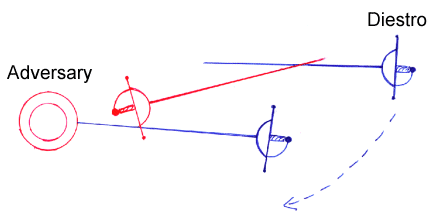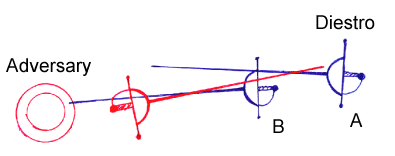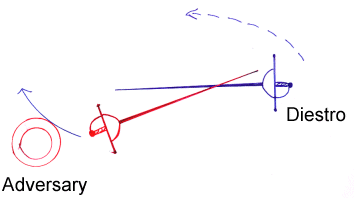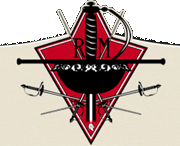
Three Destreza Attacks against the Common Vulgate Fencer
interpreted from the writings of Narvaez
interpreted from the writings of Narvaez
“Llave y gobierno de la destreza. De una filosofia de las armas.”
(1608)
The following three attacks (offensive maneuvers) from La Destreza were taken from the above mentioned treatise. I have broken down the demonstrations of Narvaez into their most common denominator by simplifying the translated Castilian into fencing terminology that is in common usage today. I would have preferred to translate the original text as it appears but since the aim of this series is to demystify I thought it prudent to use language as well as terms that any well trained fencer having a firm technical foundation can comprehend.
The word "vulgate" in the title of this article is the term used by Carranza and Narvaez when they referred to the more common form of swordsmanship practiced during their era.
The following are the demonstrations:
"Tentar" (literally meaning to feel or probe) being a well known form of making blade contact, and a crude form of Engagement, or Legamento.
If your adversary makes contact "tentar" with your sword (engages) by placing his point (punta) against the middle (medio) of your blade, in quarte, or quarta, in order to attack your face, you have three ways in which to wound him: two with curving steps "compases curvos", and the other stepping straight (recto)*.
*The attack is straight, however it is not executed against another Diestro versed in the same Spanish system, but a less trained common swordsman.

- The adversary engages in quartata with his hand held just below sternum level.
- The circles represent the adversary's body.
- The purpose of the circles is to illustrate the relationship of the Diestro's blade to the adversary's body.
- The broken line (curved arrow) represents the direction taken by the Diestro as he is moving around the adversary.
As the adversary contacts "Tentar" (engages) your blade, side step by using a curving step "compas curvo" to your left, and freeing your sword without bending your arm (disengaging, cavazione). Then by angulation of your wrist strike him by a thrust to the chest over his sword behind his hilt and towards his right side, while simultaneously continuing your circular movement, around him. Do not permit the adversary's sword to meet yours.
You can also answer this prepatory technique at the commencement of your adversary's blade contact "Tentar" (engagement, legamento) by moving in the same manner as previously described, but by an alternative attack under his sword arm. He will attempt to beat your blade away (in seconde, seconda), but your counter attack is by a back edge cut (reves) to the body (flank or lower abdomen) as you continue walking around the adversary.
[Note: In La Destreza cuts are used just as frequently as thrusts. The Spanish Masters were well aware that under certain circumstances that present themselves in actual combative situations, it is more efficient to deliver a cut than a thrust. This will be dealt with in future installments of this series.]

- A = initial position of the Diestro's weapon.
- B = the placement of the Diestro's weapon at the termination of the attack.
[This technique begins at the instant when the foible of the adversary's blade is against the forte of your blade because you have allowed him to reach further along your blade with his own.]
On the adversary's engagement with the "flaqueza" (foible) of his blade against the "fureza" (forte) of your blade, and as he moves to engage, execute a straight thrust by forcefully opposing his blade upward with your own and allowing his blade to fall against your "guarnacion" (hilt, guard) while at the same instant stepping directly at him. If on your executing the above mentioned attack, the adversary responds by lifting his point in order to attack your face, you will counter-respond by slightly lifting up your guard and impeding his attempted counter-offensive action.

- The broken line (curved arrow) represents the direction taken by the Diestro as he is moving around the adversary.
- The solid line (curved arrow) represents the direction of the cut against the adversary.
You can defend yourself and strike your adversary in two ways:
One by forming a cut over his blade. You can execute a cut to the face or upper body, just above his blade at the moment of his contacting yours. [Note: Not a cut over (coupe)] This can be done by taking a half side step if it is convenient.
An alternative response is to permit blade contact, thereby allowing the adversary initiative to move to execute a thrust. When he does this, oppose his blade and counter thrust.
The other manner in which to strike your adversary by thrust is to attack without loosing blade contact or lifting your sword from the adversary's sword. This is done by slightly reaching further with your arm while having your hand in supination. If the timing of your commitment to the action is timely, as a consequence you will also oppose his blade on your action and strike him by thrusting as previously advised.
The maneuvers described in this 17th century treatise would be described today as "attacks on the preparation." These actions require an acute sense of timing, distance, and above all "sentiment du fer" (tacto), in order to be executed correctly and efficiently.
The intention of presenting these three attacks is to open a window for the reader and provide a clearer view of the actual application of the techniques of La Destreza. By taking a "hands on" approach to Spanish Swordsmanship, it can be discovered that there really is no mystery, or magic, in the Spanish School. The only mystery is ignorance of the "how" and "why." The magic is the understanding of the "when."
"How" is the precision of the manner in which something is executed.
"Why" is the reason for which something is executed.
"When" is the correct time at which something is executed.
Principles such as the above mentioned are important to the assimilation of La Destreza. Rather than attempting to learn an infinite variety of separate techniques, the Diestro learns basic principles that can be mastered, adapted, and applied to an infinite number of circumstances The esoteric qualities of La Destreza are found in its philosophy and spiritual aspects which hopefully will be presented in future installments of this series.
